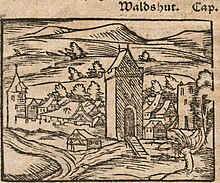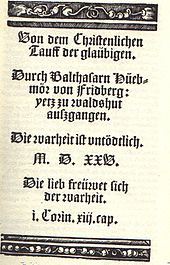Balthasar Hubmaier
Balthasar Hubmaier (also Huebmör, Hubmör, Hubmair, Hubmayr, Hubmeier; Friedberger , latinized Pacimontanus ; * around 1485 in Friedberg near Augsburg ; † March 10, 1528 in Vienna ) was a leading Anabaptist personality of the Reformation and a martyr of the Anabaptist movement .
Early years and studies
Balthasar Hubmaier was born in Friedberg between 1480 and 1485. He probably received his first education at the cathedral school in Augsburg, where he also received the minor orders . The first certain date in his biography is May 1st, 1503. On this day he was matriculated at the University of Freiburg . Hubmaier had himself entered in the register as an Augsburg clericus ( cleric ). After two semesters at Freiburg University (1504/05), Hubmaier obtained the degree of Baccalaureus Artium . Then he studied theology with Johannes Eck .
When Eck accepted a call to the University of Ingolstadt in 1510 , Hubmaier followed him there, already ordained a priest . 1512 doctorate Hubmaier the doctor of theology . In Ingolstadt he worked as a preacher at the Münster and as a university professor .
Cathedral preacher in Regensburg
In 1516 he left Ingolstadt to take the position of cathedral preacher in Regensburg . In this function he called for the persecution of the Regensburg Jews and participated in the destruction of the Regensburg synagogue . A chapel "To the beautiful Maria" was built in its place . Here Hubmaier also worked as a more talkative pilgrimage and soon became known beyond the borders of Regensburg as an enthusiastic admirer of Mary .
Waldshut: encounter with the Reformation and Anabaptism
In 1521 Hubmaier accepted the pastor's position at the Marienkirche in Waldshut and without hesitation fulfilled his duties as a Catholic priest. In 1522 he returned to Regensburg as a pilgrimage preacher. At the same time he was in contact with several humanists and began to deal intensively with the letters of Paul . In the first time in Waldshut he dealt with the Reformation writings of Martin Luther and above all with his understanding of the sacrament. On a trip to St. Gallen and Zurich he came into contact with Protestant circles and made friends with Huldrych Zwingli . In October 1523 he took part at his side in the Second Zurich Disputation. Back in Waldshut he tried to promote the Reformation and came into conflict with the old believers. He was forced to leave the city and found refuge in Schaffhausen . Here he wrote a pamphlet against violent conversion to faith under the motto “The truth is deadly” (Von heretzern vnd Irish burners) . This pamphlet was part of his defense against the accusation of heresy that Johann Eck, his former friend and Ingolstadt teacher, brought against him in Rome . In autumn 1524 he returned to Waldshut and now completed the Reformation here. He also supported Hans Müller von Bulgenbach with a manifesto. A new measuring order was introduced and the churches were cleaned of images ( iconoclasm ). Hubmaier also criticized his own practice of worshiping images during the Regensburg Marian pilgrimage as falling down in front of the images or as idolatry . Encouraged by the writings of Karlstadt and Müntzer , whom he presumably met in Waldshut, and the conversations with the Anabaptist Wilhelm Reublin , who had been expelled from Zurich , he began to deal more and more with the question of baptism and spoke out publicly against child baptism . At Easter 1525 he took action and was baptized by Wilhelm Reublin together with 60 other Waldshutern . Then Hubmaier himself baptized a large part of the council and the population of Waldshut. When the town was occupied by Habsburg troops under Rudolf V von Sulz as a result of the peasant war at the end of 1525 and forced back to Catholicism , he fled. Together with his wife Elsbeth Hügline , whom he married on January 13, 1525, he found refuge with Anabaptist friends in Zurich.
Hubmaier as an Baptist in Moravia
The final break with Zwingli came after he had justified his conception of baptism in what is probably the most important work On the Christian Baptism of Believers . He was then arrested in Zurich and revoked his Anabaptist position after he was threatened with the death penalty. In April 1526 he was able to leave Zurich and came to Nikolsburg via Constance and Augsburg . There he opposed the non-violence taught and practiced in many Anabaptist circles. He called for armed resistance against the "Turkish threat" - supporting his protectorate in Nikolsburg.
In Moravia , Hubmaier wrote another 18 writings, through which he exerted great influence on the Anabaptist circles. These writings revolve thematically around the well-known Anabaptist doctrinal concepts: rejection of infant baptism, congregational discipline and rejection of the oath . It is reported that Hubmaier baptized more than 2000 followers in Moravia.
The Archduke of Austria, Ferdinand I , his old enemy from the Waldshut era, had him arrested in July 1527 on charges of rebellion. He was incarcerated at Kreuzenstein Castle near Vienna and interrogated on questions of faith. During his imprisonment he wrote the Account of Faith addressed to Ferdinand , in which he clearly confessed himself to be an Baptist. He turned down the offer of revocation and was burned at the stake on March 10, 1528 at the Stubentor in Vienna as a rebel and heretic . Three days after his execution, his wife was drowned in the Danube. The Council of Trent describes him as "heresy archen" (author of a heresy).
Christening succession
The line of baptismal succession goes back to Balthasar Hubmaier via Wilhelm Reublin (January 1525), Jörg Blaurock (January 1525) to Konrad Grebel (January 1525). The dates in brackets indicate the respective baptism date. Evidence of this can be found in the biography articles of the persons mentioned.
Works (selection)
- In this little book the wonderful Zaychen are included in Regensburg to the beautiful Mary the Mother of God , Nuremberg near Höltzel (1520)
- Of heretics and Irish burners (1524)
- Ain Summ aintz whole Christian life. By Baldasaren Frydberger, Predicant yetz zu Waldßhütt, registered to the three churches of Regensburg, Ingolstat and Frydberg, his dear lords, brothers and sisters in god the lord. Especially ain report the children Touff and the night time important. (1525)
- From the Christian baptism of believers (1525)
- Short Our Father (1526)
- A talk by Balthasar Huebmörs von Fridberg, Doctors, on Mayster Vlrichs Zwinglens zu Zürich's little christening book (1526)
- A Christian blank tablet that every person should know before he is baptized and baptized in water (1526)
- The ancient and new teachers' judgment that young children should not be baptized until they are instructed in the faith (Nikolsburg 1526)
- From the Briederlichen taut. Where it is not there, there is certainly no church, whether the water fountain and Christ's night painting are already being held there (1527)
- From the Christian ban (1527)
- Of the freedom of the will, which God through his sent word to all people, and to those who are violent, his willingness to want good and zethon. Or sy but khinder of anger, as sy are by nature, let ze stay (1527)
- Accountability of Faith (1528)
An edited collection of his writings can be found in:
- Balthasar Hubmaier: Writings . Edited by Gunnar Westin, Gütersloh 1962 ( sources on the history of the Anabaptists 9).
Literature (selection)
- Christof Windhorst: Balthasar Hubmaier. Professor, preacher, politician . In: Hans-Jürgen Goertz (ed.): Radical Reformers. 21 biographical sketches from Thomas Müntzer to Paracelsus . Munich 1978, pp. 125-136.
- Christof Windhorst: Anabaptist understanding of baptism: Balthasar Hubmaier's teaching between traditional and reformatory theology . Leiden 1976.
- Torsten Bergsten: Balthasar Hubmaier. His position on the Reformation and Anabaptism (1521–1528) . Kassel 1961.
- Robert Dollinger: Balthasar Hubmaier . In: RGG, 3.1959 - column 464 f.
- Johann Loserth: Doctor Balthasar Hubmaier and the beginnings of rebaptism in Moravia . Rohrer, Brno 1893.
- Eddie L. Mabry: Balthasar Hubmaier's understanding of faith . Univ. Press of America, Lanham / New York / Oxford 1998, ISBN 0-7618-1220-2 .
- Carl Sachsse: D. Balthasar Hubmaier as theologian . Scientia-Verl., Aalen 1973, ISBN 3-511-04290-9 (repr. Of the Berlin 1914 edition).
- Alfred Stern : Hubmaier, Balthasar . In: Allgemeine Deutsche Biographie (ADB). Volume 13, Duncker & Humblot, Leipzig 1881, pp. 264-267.
- Bernd Moeller: Hubmaier, Balthasar. In: New German Biography (NDB). Volume 9, Duncker & Humblot, Berlin 1972, ISBN 3-428-00190-7 , p. 703 ( digitized version ).
- Ulrich J. Gerber: Hubmaier, Balthasar. In: Historical Lexicon of Switzerland .
- Samuel Henri Geiser : The baptismal congregations . Self-published, 2nd edition 1971. Pages 143, 148, 155, 168 f., 177, 221, 224, 230-236, 238, 250, 261 f., 266, 328-330, 337.
- Hans-Jürgen Goertz : The Anabaptists. History and interpretation . C. H. Beck Verlag, Munich 1980.
Web links
- Literature by and about Balthasar Hubmaier in the catalog of the German National Library
- Publications from and about Balthasar Hubmaier in VD 16 .
- James M. Stayer: Hubmaier, Balthasar. In: Mennonite Lexicon . Volume 5 (MennLex 5).
- Johann Loserth, William R. Estep: Hubmaier, Balthasar (1480? -1528) . In: Global Anabaptist Mennonite Encyclopedia Online
- Wolfgang Burk: Hubmaier's biography ( memento from May 9, 2001 in the Internet Archive ) on the homepage of the Evangelical Free Church Community in Waldshut.
- Texts by Balthasar Hubmaier in the voice of faith
Individual evidence
- ↑ J. Gordon Melton: Hübmaier, Balthasar (1481-1528) martyred Anabaptist leader . In: Encyclopedia of World Religions . Encyclopedia of Protestantism, No. 6 . Facts of File, New York 2005, ISBN 0-8160-5456-8 , pp. 272 (English, "Balthasar Hübmaier was born in Freiburg, Bavaria, in 1481").
- ↑ See L. Theobald: Balthasar Hubmaier . In: Journal for Bavarian Church History . Erlangen 1941, p. 153.
- ↑ a b H. Mayer (Ed.): The University of Freiburg im Breisgau (1460 - 1656) . Freiburg im Breisgau 1907, p. 150.
- ↑ Torsten Bergsten: Balthasar Hubmaier. His position on the Reformation and Anabaptism. 1521-1528 . Kassel 1961, p. 71.
- ↑ a b Windhorst (1976).
- ↑ Torsten Bergsten: Balthasar Hubmaier . 1961, p. 175.
- ↑ Torsten Bergsten: Balthasar Hubmaier . 1961, p. 92.
| personal data | |
|---|---|
| SURNAME | Hubmaier, Balthasar |
| ALTERNATIVE NAMES | Huebmör; Friedberger; Pacimontanus |
| BRIEF DESCRIPTION | Baptist personality of the Reformation period |
| DATE OF BIRTH | around 1485 |
| PLACE OF BIRTH | Friedberg near Augsburg |
| DATE OF DEATH | March 10, 1528 |
| Place of death | Vienna |





